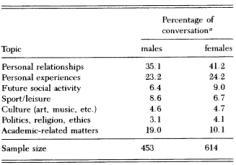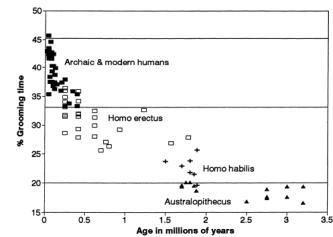Language is important to us modern humans so asking why it evolved seems like a silly question. After all, surely we can think of numerous benefits of language that drove its evolution in our ancestors. However, idle speculation is not good enough for science. We need data! Which of the many benefits to language we can think of was the reason it was selected for? Was it to allow better communication whilst hunting, to better teach complex tool-making techniques.
Or maybe it was to better gossip. That’s the idea proposed by Aiello and Dunbar in 1993; and remains one of the most popular and well supported explanations for why language evolved. It’s based on the social brain hypothesis (also developed by Dunbar), which points out that living in larger groups is beneficial. Since living in such large groups is intellectually demanding, requiring you to remember lots of faces etc., it would act as a selection pressure for large brains; explaining why humans have such big noggins (Dunbar, 2003).
However, if you’re living in a larger group you need to invest more time in socialising since you need to bond with more people. If the group is too big, the time you spend socialising can detract from time you need to spend foraging for food, sleeping or engaging in other wholesome ape activities. As such there’s a limit to the amount of time you can spend socialising. Studying modern primates has revealed that this is ~20% of your daily time-budget.

When apes invented the iPad, they found it even harder to find the time to socialise with others
But because humans have such large groups (and large brains) we should have to dedicate more than 20% of our time to bonding with each other. Fortunately we don’t have to because we can socialise with a greater efficency than modern primates. They bond by grooming each other, a process which can only involve two individuals at once. We can use language to talk to multiple individuals at once, reinforcing more social bonds simultaneously.

The amount of time we spend talking about shit
So, since language is more efficient we can maintain larger groups and still only spend 20% of our time making sure we’re still friends with everyone in them. This would explain why over 60% of the conversations we have don’t convey any “useful” information but are simply social (or “gossipy”, to use the technical term) in nature (Dunbar, 1993). We have these social conversations to reinforce social relationships, not teach us anything.
Further, since the rise of language is linked to group size we can examine the size of the groups our ancestors lived in to get an estimate for when language may have originally evolved. The relationship between group size and brain size identified by the social brain hypothesis can be used to predict how large a group our extinct ancestors lived in.
These figures suggest that Homo erectus (who lived ~1.8 million years ago and was the first of our ancestors with the modern body-plan) was the first to start living in groups that were too large for grooming alone to maintain, so language must have developed at some point around then.

How much time we’d have to spend grooming if language didn’t evolve. Based on this Aiello and Dunbar concluded it must have developed by the time of Homo erectus
Of course, this doesn’t mean that the other benefits of language weren’t involved in it’s evolution, just that reinforcing social bonds appears to have been the most important. Further, these conclusions are far from concrete and liable to revision as new data comes in. For example, the stuff about the amount of time humans spend gossiping was based on a rather small sample size. But then, just because you need to take a pinch of salt with it doesn’t mean the whole hypothesis is worthless.
So the next time you get frustrated with the sheer amount of drivel on Facebook, relax. They’re only using language for its evolutionary-intended purpose.
References
Aiello, L. C., & Dunbar, R. I. (1993). Neocortex size, group size, and the evolution of language. Current Anthropology, 34(2), 184-193.
Dunbar, R. I. (1993). Coevolution of neocortical size, group size and language in humans. Behavioral and brain sciences, 16(4), 681-693.
Dunbar, R. I. (2003). The social brain: mind, language, and society in evolutionary perspective. Annual Review of Anthropology, 163-181.

